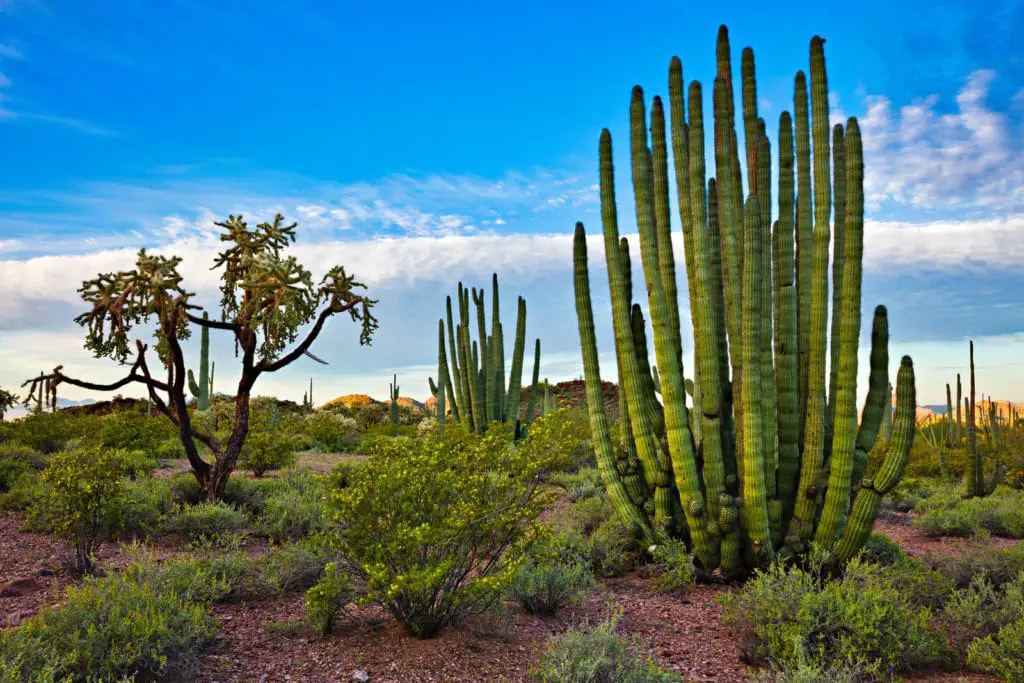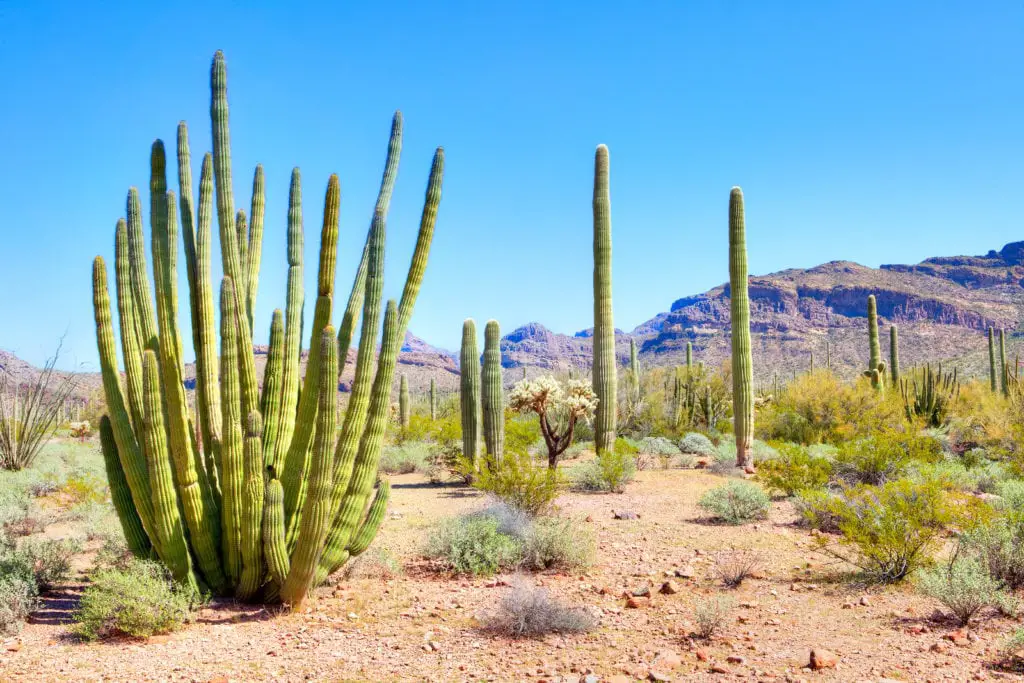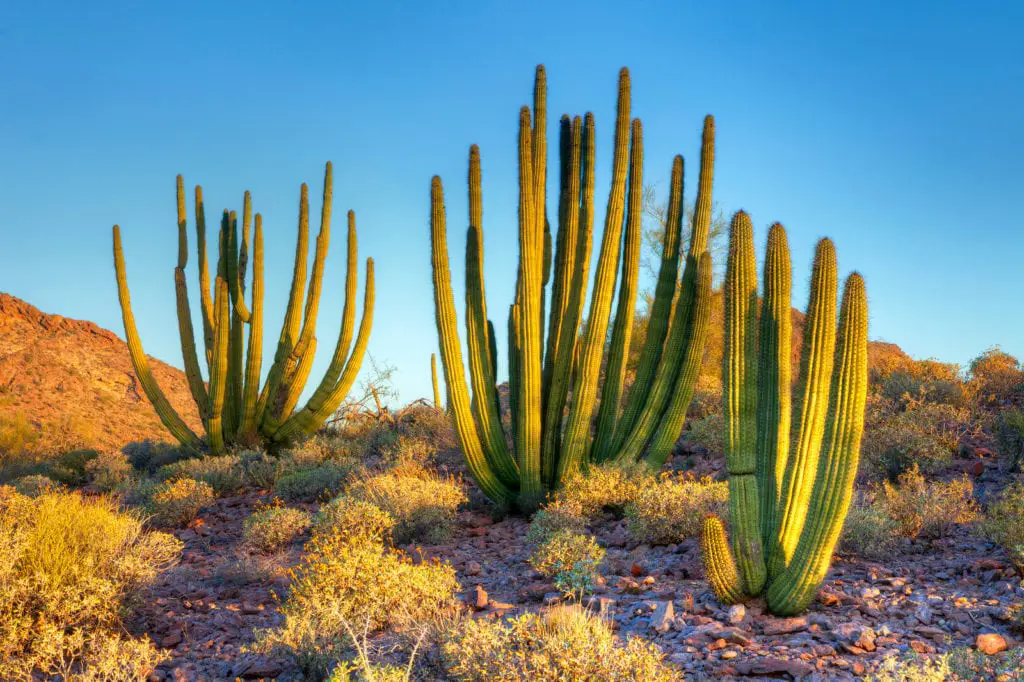On the border of Mexico and the United States lies a unique national monument, Organ Pipe Cactus National Monument. This UNESCO biosphere reserve is located in southern Arizona, near the town of Ajo, Arizona. Organ Pipe Cactus National Monument draws visitors from around the world every year, as it the only place in the United States where the organ pipe cactus grows wild. Along with the organ pipe cactus, the reserve is home to many other cacti and other plant life.
Organ Pipe Cactus National Monument is a wonderful place to visit when you’re in Arizona. The relative quietness of the reserve compared to other national parks will leave you with a sense of sereneness and connection to nature after your visit. And, you’ll have seen one of the few places where the organ cactus grows wild!
Since it is less popular than other destinations, we thought it’d be helpful to crowdsource all the information you need to know right here in this article. Keep reading and we’ll give you the low-down on what the park is known for, the top spots to see, hiking/trail information, camping information, and where to stay when you visit.
1. What is Organ Pipe Cactus National Monument known for?
Above all, Organ Pipe Cactus National Monument is known for the organ pipe cacti. The organ pipe cactus is a species that is native to the United States and Mexico, as it lives in rocky desert environments. It was named for its resemblance to the pipe organ.
While organ pipe cactus, known as “pitaya dulce” in Spanish, is mostly found in northern Mexico (Sonora and southern Baja California), it still grows wild in this region of Arizona. That’s why the Organ Pipe Cactus National Monument is such an important reserve – it is the only place in the United States where this cactus grows wild, and therefore, one of the only places you can see it growing in its natural habitat.

The reserve is in the Sonoran Desert but in an area that is uniquely green, rather than the normal desert light brown. There, a variety of plants and animals live freely and thrive. Along with the organ pipe cactus, you may see other cacti and desert succulents, rare plants (the desert caper, night-blooming cereus, etc.) and different trees and shrubs. There is no shortage of animals, either. Organ Pipe Cactus National Monument is home to bats, mountain lions, kangaroo rats, javelina, desert bighorn sheep, and more. Depending on the weather and season, you may be lucky enough to see a large variety of wildlife during your trip.
Another unique aspect of Organ Pipe Cactus National Monument is its dedicated equestrian trails. While visiting the park, you may ride along any of the dedicated, existing trails. A great way to explore this desert region is by horse, so definitely consider this as an option. Additionally, you can hike, drive, or bike the reserve. We recommend deciding based on preference and fitness level. The park is beautiful regardless of how you choose to see it, so think about whether you’d rather spend your day hiking through dedicated trails or the backcountry, atop a horse, or in a car.
2. What are the top spots to see in Organ Pipe Cactus National Monument?
Organ Pipe Cactus National Monument is a large park, covering 517 square miles of space. There is a ton to see in the park, varying from different cacti formations to scenic drives. So, we compiled our top three favorite places that you cannot miss when you visit:
- Ajo Mountain Drive
- Quitobaquito Springs
- Estes Canyon/Bull Pasture
Ajo Mountain Drive
Perhaps the most popular activity at Organ Pipe Cactus National Monument is Ajo Mountain Drive, a 21-mile scenic drive. Visitors love Ajo Mountain Drive, as it is a wonderful and somewhat comprehensive view of the park. The drive passes through a variety of terrains, including both desert and mountain. It is a loop that has a view of the foothills of the Ajo Range.
While the drive is mostly on unpaved gravel, it is typically passable by your standard passenger car. If you do not have a car, you can take a three-hour guided tour starting at the Kris Eggle Visitor Center for $5.
Quitobaquito Springs
Quitobaquito Springs, meaning “house ring spring” in the Tohono O’odham language are springs located in Organ Pipe Cactus National Monument. This area has been home to plant life, wildlife, and even human life for at least 16,000 years. Through the years, different ancient peoples and cultures have occupied the land, making it an important historical site for us today. Nowadays, it is still home to much wildlife and plant life, including some endangered species. These beautiful natural springs should not be missed when visiting Organ Pipe Cactus National Monument! You may drive to Quitobaquito Springs and park in the nearby parking lot. Depending on the time of day, season, and amount of people there, you may get lucky enough to spot some of the endangered species in their natural habitat.
Estes Canyon/Bull Pasture
Estes Canyon and Bull Pasture are two popular spots visitors see during the Bull Pasture/Estes Canyon Trail. We’ll give you details on the trail later, but first – what is Estes Canyon and Bull Pasture?
Estes Canyon is a canyon that is visible from the trail in Organ Pipe Cactus National Monument. It is a beautiful canyon, telling of the desert environment that the reserve is located in. Bull Pasture is an elevated plateau/large basin, also visible from the trail. Sitting at a high elevation of 3,100 feet, Bull Pasture overlooks Estes Canyon.
These spots can get really hot during the summer, so make sure you are properly prepared for the weather and have lots of water with you! If you are going to hike instead of drive, be sure to wear the right clothing and pack lots of snacks.

3. Hiking/Trails Information
Organ Pipe Cactus National Monument has a variety of hiking options, including a hiking challenge: Hike for Health Challenge. The National Park Service splits up their designated trails into four sections:
- Visitor Center and Campground Trails
- Ajo Mountain Drive Trails
- Puerto Blanco Mountain Trails
- Alamo Canyon Trails
Additionally, backcountry hiking/camping is allowed in specifically designated areas – visit the Kris Eggle Visitor’s Center for more information.
Hike for Health Challenge
The Hike for Health Challenge is a fun hiking challenge/virtual scavenger hunt you can participate in with your family or by yourself. All of the rules are available at the visitor’s center and on the website. This challenge encourages people to get active and move around. Once you complete the challenge, you get to pick up a reward.
Recommended Trails
Visitor Center and Campground Trails:
- Visitor Center Nature Trail (0.1-mile round-trip; Easy; Accessible; Pets allowed)
- Campground Perimeter Trail (1-mile round-trip; Easy; Pets allowed)
- Desert View Trail (1.2-miles round-trip; Easy)
Ajo Mountain Drive Trails
- County Road 131 (8-miles round-trip; Easy to Moderate)
- Arch Canyon (1.2-miles round-trip; Easy)
- Bull Pasture (3-miles round-trip; Challenging)
- Estes Canyon (3-miles round-trip; Moderate)
Puerto Blanco Mountain Trails
- Senita Basin Trailhead
- Red Tanks Tinaja
- Baker Mine
- Lost Cabin
- Milton Mine
- Victoria Mine
- Dripping Springs
- Dripping Springs Mine
Trail-specific information is not provided; find out more from the trail map.
Alamo Canyon Trails
- Alamo Canyon (2-miles round-trip; Easy)
4. Camping Information
Organ Pipe Cactus National Monument is a great place to go camping. There are two dedicated campgrounds, backcountry camping is allowed, and one of the most peaceful environments ever, there’s no reason not to pack your tent when you visit the reserve. Here’s some important information about camping in the park.
The two dedicated campgrounds are Twin Peaks Campground and Alamo Campground.
- Twin Peaks Campground: 34 tent-only sites; 174 RV sites; restrooms; some showers; no hookups; $20 per night; reserve in advance January – March, first-come-first-served otherwise
- Alamo Campground: 4 tent-only site; no water available; $12 per night; first-come-first-served
If you’re an experienced camper looking for privacy, backcountry camping is allowed with a permit. There are nine backcountry camping zones, each requiring a permit. The permit costs $5 per group and lasts for seven nights.
As always, be sure to read Organ Pipe Cactus National Monument’s rules, regulations, and guidelines for both camping and hiking. The weather varies quite a bit depending on season and time of day, so make sure you are properly prepared.
5. Where to Stay in Organ Pipe Cactus National Monument
If you want to stay in the national monument, you must camp. But if camping doesn’t float your boat, there are plenty of options near Organ Pipe Cactus National Monument where you can find comfortable accommodation at a price you’re comfortable with.
Ajo, Arizona is the town closest to Organ Pipe Cactus National Monument and it is well-suited to accommodate tourists visiting the reserve. The town itself is a quaint, small-town that has a fun Arizona character with a splash of Mexican culture. Most visitors choose to stay at hotels or motels, though you can also try your luck with AirBnB’s!
Here are some recommended hotels and motels close to Organ Pipe Cactus National Monument:
Organ Pipe Cactus National Monument is an awesome vacation destination for those of you looking to get to know the United States and its nature without all the hustle and bustle of a big national park. At this unique reserve, you’ll be thrown into the desert and allowed to explore on your own time, at your own pace, and in your own manner. Whether you spend your time on a long backpacking trip or take a horse through the cacti, you’ll come out feeling refreshed and amazed by all of the beauty you’ve seen.

